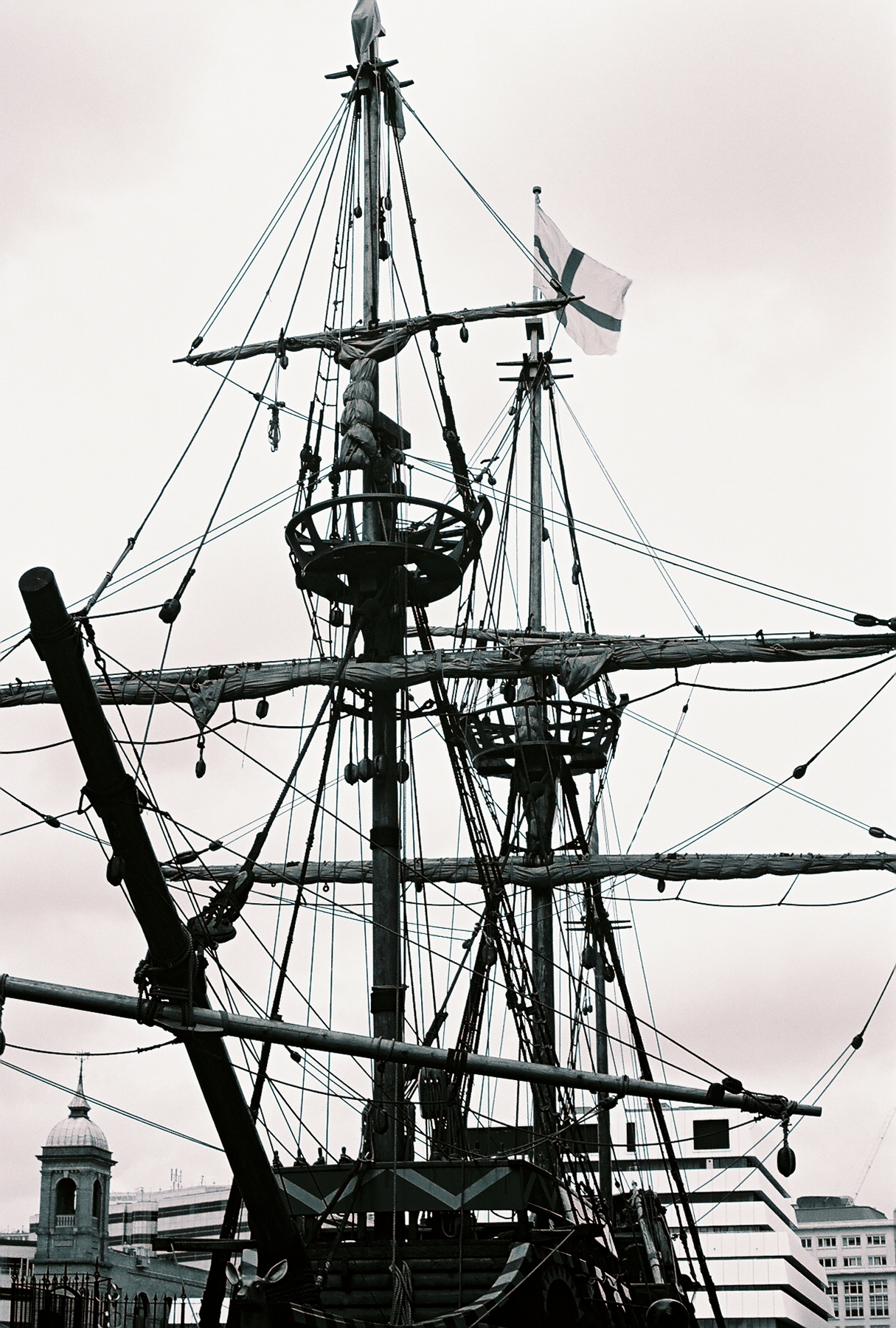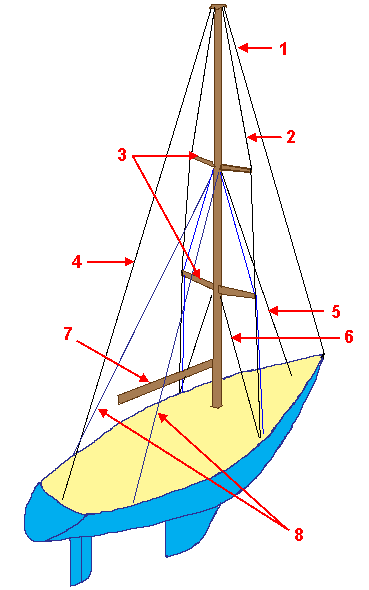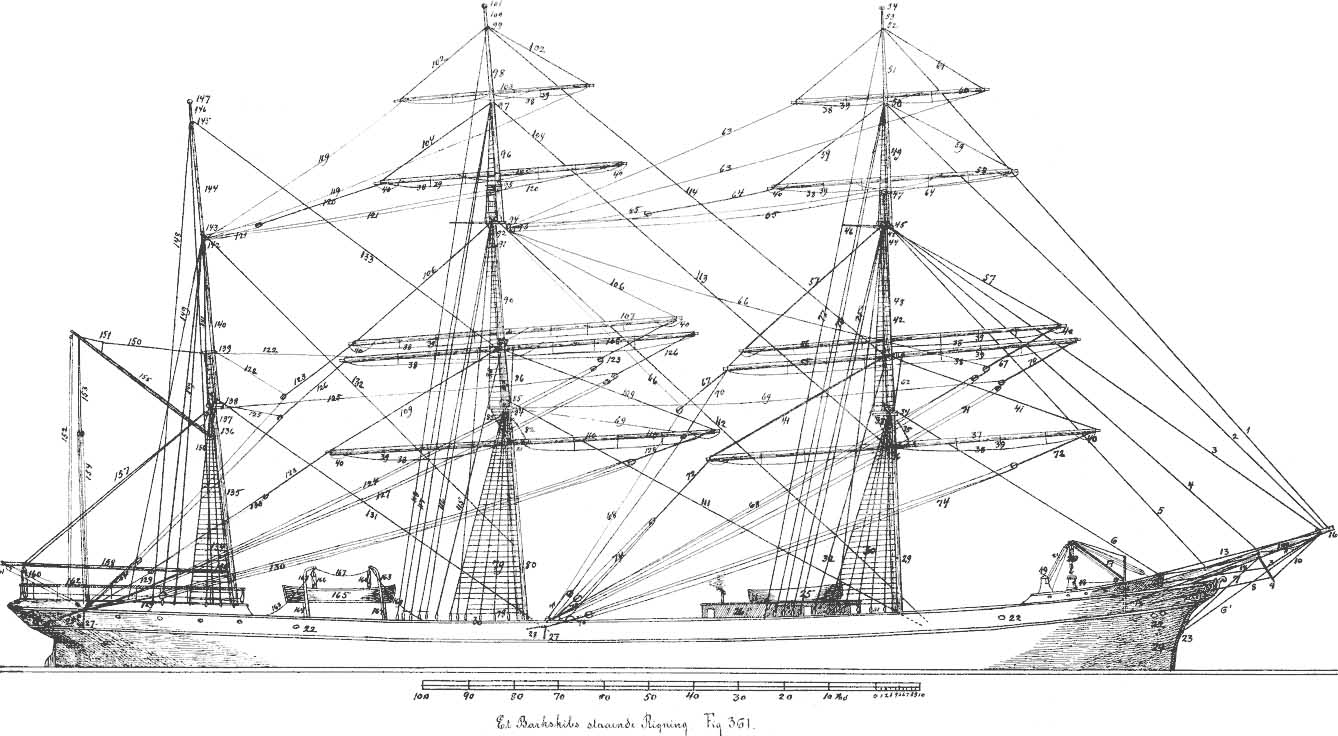Sidestay on:
[Wikipedia]
[Google]
[Amazon]



 Rigging comprises the system of ropes, cables and chains, which support and control a
Rigging comprises the system of ropes, cables and chains, which support and control a



 Rigging comprises the system of ropes, cables and chains, which support and control a
Rigging comprises the system of ropes, cables and chains, which support and control a sailing ship
A sailing ship is a sea-going vessel that uses sails mounted on Mast (sailing), masts to harness the power of wind and propel the vessel. There is a variety of sail plans that propel sailing ships, employing Square rig, square-rigged or Fore-an ...
or sail boat
A sail is a tensile structure, which is made from fabric or other membrane materials, that uses wind power to propel sailing craft, including sailing ships, sailboats, windsurfers, ice boats, and even sail-powered land vehicles. Sails may b ...
's masts and sails. ''Standing rigging'' is the fixed rigging that supports masts including shrouds and stays. ''Running rigging'' is rigging which adjusts the position of the vessel's sails and spars including halyard
In sailing, a halyard or halliard is a line (rope) that is used to hoist a ladder, sail, flag or yard. The term "halyard" derives from the Middle English ''halier'' ("rope to haul with"), with the last syllable altered by association with the E ...
s, braces, sheets and vangs.
Etymology
According to theEncyclopædia Britannica Eleventh Edition
The ''Encyclopædia Britannica'' Eleventh Edition (1910–1911) is a 29-volume reference work, an edition of the ''Encyclopædia Britannica''. It was developed during the encyclopaedia's transition from a British to an American publication. So ...
"rigging" derives from Anglo-Saxon
The Anglo-Saxons, in some contexts simply called Saxons or the English, were a Cultural identity, cultural group who spoke Old English and inhabited much of what is now England and south-eastern Scotland in the Early Middle Ages. They traced t ...
''wrigan'' or ''wringing'', "to clothe". The same source points out that "rigging" a sailing vessel refers to putting all the components in place to allow it to function, including the masts, spars, sails and the rigging.
History
Theophrastus
Theophrastus (; ; c. 371 – c. 287 BC) was an ancient Greek Philosophy, philosopher and Natural history, naturalist. A native of Eresos in Lesbos, he was Aristotle's close colleague and successor as head of the Lyceum (classical), Lyceum, the ...
in his '' History of Plants'' ( 300 BCE) states that the rigging on King Antigonus' fleet was made from papyrus reed
''Cyperus papyrus'', better known by the common names papyrus, papyrus sedge, paper reed, Indian matting plant, or Nile grass, is a species of aquatic flowering plant belonging to the sedge family Cyperaceae. It is a tender herbaceous perennial ...
.
Types of rigging
Rigging is divided into two classes, ''standing
Standing, also referred to as orthostasis, is a position in which the body is held in an upright (orthostatic) position and supported only by the feet. Although seemingly static, the body rocks slightly back and forth from the ankle in the ...
'', which supports the mast (and bowsprit), and ''running'', which controls the orientation of the sails and their degree of reefing
Reefing reduces the area of a sail, usually by folding or rolling one edge of the canvas in on itself and attaching the unused portion to a Spar (sailing), spar or a , as the primary measure to preserve a sailing vessel's stability in strong wi ...
. Configurations differ for each type of rigging, between ''fore-and-aft rig
A fore-and-aft rig is a sailing ship rig with sails set mainly in the median plane of the keel, rather than perpendicular to it, as on a square-rigged vessel.
Description
Fore-and-aft rigged sails include staysails, Bermuda rigged sails, g ...
ged'' vessels and ''square-rig
Square rig is a generic type of sail and rigging arrangement in which a sailing vessel's primary driving sails are carried on horizontal spars that are perpendicular (or square) to the median plane of the keel and masts of the vessel. These s ...
ged'' vessels.
Standing
Standing rigging
Standing rigging comprises the fixed lines, wires, or rods, which support each mast or bowsprit on a sailing vessel and reinforce those spars against wind loads transferred from the sails. This term is used in contrast to running rigging, w ...
is cordage which is fixed in position. Standing rigging is almost always between a mast and the deck, using tension to hold the mast firmly in place. Due to its role, standing rigging is now most commonly made of steel cable. It was historically made of the same materials as running rigging, only coated in tar for added strength and protection from the elements.
Fore-and-aft rigged vessels
Most fore-and-aft rigged vessels have the following types of standing rigging: aforestay
On a sailing vessel, a forestay, sometimes just called a stay, is a piece of standing rigging which keeps a mast from falling backwards. It is attached either at the very top of the mast, or in fractional rigs between about 1/8 and 1/4 from the t ...
, a backstay
A backstay is a piece of standing rigging on a sailing vessel that runs from the mast to either its transom or rear quarter, counteracting the forestay and jib. It is an important sail trim control and has a direct effect on the shape of the ma ...
, and upper and lower shrouds (side stays).
Less common rigging configurations are diamond stays and jumpers. Both of these are used to keep a thin mast in column especially under the load of a large down wind sail or in strong wind.
Rigging parts include swageless terminals, swage terminals, shackle toggle terminals and fail-safe wire rigging insulators.
Square-rigged vessels
Whereas 20th-century square-rigged vessels were constructed of steel with steel standing rigging, prior vessels used wood masts with hemp-fiber standing rigging. As rigs became taller by the end of the 19th century, masts relied more heavily on successive spars, stepped one atop the other to form the whole, from bottom to top: the ''lower mast'', ''top mast'', and ''topgallant mast''. This construction relies heavily on support by a complex array of stays and shrouds. Each stay in either the fore-and-aft or athwartships direction has a corresponding one in the opposite direction providing counter-tension. Fore-and-aft the system of tensioning start with the stays that are anchored in front of each mast. Shrouds are tensioned by pairs ofdeadeye
A deadeye is an item used in the standing and running rigging of traditional sailing ships. It is a smallish round thick wooden (usually lignum vitae) disc with one or more holes through it, perpendicular to the plane of the disc. Single and tri ...
s, circular blocks that have the large-diameter line run around them, whilst multiple holes allow smaller line—''lanyards''—to pass multiple times between the two and thereby allow tensioning of the shroud. In addition to overlapping the mast below, the top mast and topgallant mast are supported laterally by shrouds that pass around either a platform, called a "top
Top most commonly refers to:
* Top, a basic term of orientation, distinguished from bottom, front, back, and sides
* Spinning top, a ubiquitous traditional toy
* Top (clothing), clothing designed to be worn over the torso
* Mountain top, a moun ...
", or cross-wise beams, called "crosstrees
Crosstrees are the two horizontal spars at the upper ends of the topmasts of sailing ships that are used to anchor the shrouds from the topgallant mast. They may also be mounted at the upper end of the topgallant to anchor the shrouds from the ...
". Each additional mast segment is supported fore and aft by a series of stays that lead forward. These lines are countered in tension by backstays, which are secured along the sides of the vessel behind the shrouds.
Running
Running rigging
Running rigging is the rigging of a sailing, sailing vessel that is used for raising, lowering, shaping and controlling the sails on a sailing vessel—as opposed to the standing rigging, which supports the Mast (sailing), mast and bowsprit. Runn ...
is the cordage used to control the shape and position of the sails. Materials have evolved from the use of Manilla rope to synthetic fibers, which include dacron
Polyethylene terephthalate (or poly(ethylene terephthalate), PET, PETE, or the obsolete PETP or PET-P), is the most common thermoplastic polymer resin of the polyester family and is used in fibres for clothing, containers for liquids and foods ...
, nylon
Nylon is a family of synthetic polymers characterised by amide linkages, typically connecting aliphatic or Polyamide#Classification, semi-aromatic groups.
Nylons are generally brownish in color and can possess a soft texture, with some varieti ...
and kevlar
Kevlar (para-aramid) is a strong, heat-resistant synthetic fiber, related to other aramids such as Nomex and Technora. Developed by Stephanie Kwolek at DuPont in 1965, the high-strength material was first used commercially in the early 1970s as ...
.
Running rigging varies between ''fore-and-aft rigged'' vessels and ''square-rigged'' vessels. They have common functions between them for supporting, shaping and orienting sails, which employ different mechanisms. For supporting sails, halyard
In sailing, a halyard or halliard is a line (rope) that is used to hoist a ladder, sail, flag or yard. The term "halyard" derives from the Middle English ''halier'' ("rope to haul with"), with the last syllable altered by association with the E ...
s (sometimes haulyards), are used to raise sails and control luff tension. On gaff-rig
Gaff rig is a sailing rig (configuration of sails, mast and stays) in which the sail is four-cornered, fore-and-aft rigged, controlled at its peak and, usually, its entire head by a spar (pole) called the ''gaff''. Because of the size and sh ...
ged vessels, topping lift
The topping lift (more rarely known as an uphaul) is a line which applies upward force on a boom on a sailboat.
Part of the running rigging, topping lifts are primarily used to hold a boom up when the sail is lowered. This line would run from n ...
s hold the yards across the top of the sail aloft. Sail shape is usually controlled by lines that pull at the corners of the sail, including the outhaul
An outhaul is a control line found on a sailboat. It is an element of the running rigging, used to attach the mainsail clew to the boom and tensions the foot of the sail. It commonly uses a block at the boom end and a cleat on the boom, closer ...
at the clew
Sail components include the features that define a sail's shape and function, plus its constituent parts from which it is manufactured. A sail may be classified in a variety of ways, including by its orientation to the vessel (e.g. ''fore-and-a ...
and the downhaul
The downhaul is a line which is part of the rigging on a sailboat; it applies downward force on a spar or sail. The most common downhaul on a modern sailboat is attached to the spinnaker pole, though this may be referred to as the foreguy in so ...
at the tack
Thermoproteati is a kingdom of archaea. Its synonym, "TACK", is an acronym for Thaumarchaeota (now Nitrososphaerota), Aigarchaeota, Crenarchaeota (now Thermoproteota), and Korarchaeota (now Thermoproteota), the first groups discovered. They ...
on fore-and-aft rigs. The orientation of sails to the wind is controlled primarily by sheets, but also by braces, which position the yard arms with respect to the wind on square-rigged vessels.
See also
*Full-rigged ship
A full-rigged ship or fully rigged ship is a sailing ship, sailing vessel with a sail plan of three or more mast (sailing), masts, all of them square rig, square-rigged. Such a vessel is said to have a ship rig or be ship-rigged, with each mas ...
* Bermuda rig
Bermuda rig, Bermudian rig, or Marconi rig is a type of sailing rig that uses a triangular sail set abaft (behind) the mast. It is the typical configuration for most modern sailboats. Whilst commonly seen in sloop-rigged vessels, Bermuda rig is ...
* Lateen rig
A lateen (from French ''latine'', meaning "Latin") or latin-rig is a triangular sail set on a long Yard (sailing) , yard mounted at an angle on the mast (sailing) , mast, and running in a fore-and-aft direction. The Settee (sail), settee can be ...
* Junk rig
The junk rig, also known as the Chinese lugsail, Chinese balanced lug sail, or sampan rig, is a type of sail rig in which rigid members, called battens, span the full width of the sail and extend the sail forward of the mast.Hasler & MacLeod, ...
* Shipbuilding
Shipbuilding is the construction of ships and other Watercraft, floating vessels. In modern times, it normally takes place in a specialized facility known as a shipyard. Shipbuilders, also called shipwrights, follow a specialized occupation th ...
* Superstructure
A superstructure is an upward extension of an existing structure above a baseline. This term is applied to various kinds of physical structures such as buildings, bridges, or ships.
Aboard ships and large boats
On water craft, the superstruct ...
References
Further reading
* * * * *External links
{{Authority control Sailing rigs and rigging Marine occupations